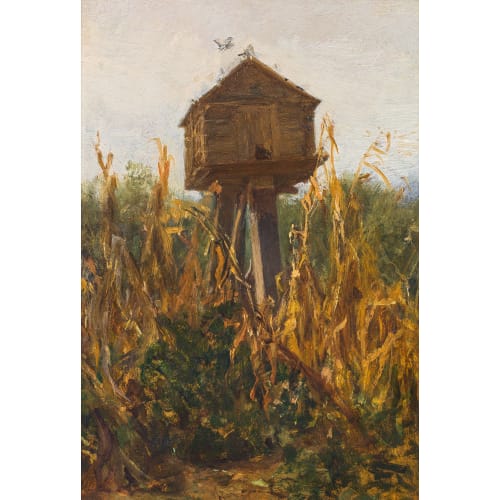August von Pettenkofen began his studies at the Vienna Academy of Fine Arts in 1837 at the age of fifteen years. Apart from painting he was also concerned with lithography and published political as well as sociocritical caricatures in the newspapers “Der Kobold” and “Wiener Blätter”. An originally intended military career he quitted in favor of private studies under Franz Eybl, a highly appreciated realistic Biedermeier-painter. Under influence of Eybl he started painting portraits and genre-scenes. In 1848/49 he took part as war-artist in the emperor’s Hungary-campaign, but his shocking depictions of injured soldiers (today in the Belvedere Museum, Vienna) originate only from the years 1852/53 when he had been in France for the first time and was impressed by Barbizon-painters. His first visit of France was followed by further 17 sojourns in Paris. Sort of a pendant to the Barbizon painters` colony he found in Hungarian Szolnok. There the special and intense light of the lowlands, the wide sky and picturesque villages inspired him. His small-format paintings were a contrast to contemporary large size history-paintings by Hans Makart or Hans Canon and can be named first “plein-air” paintings in Austria. Pettenkofen cultivated friendships with many artist of the time and lived very cosmopolitan: for many years he shuttled between Vienna, Szolnok and Paris and stayed for many times in Venice in the studio of his friend Leopld Carl Müller who internationally succeeded as orientalist painter. Pettenkofen had also many contacts to the Netherlands and became member of the Amsterdam Academy in 1857. Although Pettenkofen didn´t take part at exhibitions he successfully sold his paintings via the Paris Gallery of Charles Sedelmeyer. In 1874 Pettenkofen was appointed professor at the Vienna Academy. In his art Pettenkofen build a bridge from Biedermeier-realism to French “plein-air” painting of the School of Barbizon. In his late work he prepared Austria´s variety of impressionism called “Stimmungsmalerei” which came up in the 1870ties. This late work is dominated by watercolors, gouaches and pastels showing a liberated, open brushstroke and decomposed forms. Works by Pettenkofen are collected e.g. in the Belvedere Museum Vienna, Leopold Museum Vienna, Albertina Vienna, The Metropolitan Museum New York, Eremitage St. Petersburg.
Literature
August Ritter von Pettenkofen. Künstlerischer Nachlaß, H.O. Miethke, Künstlerhaus, Wien 1890; A. Weixlgärtner, August Pettenkofen. 1822-1889, Wien 1916; A. Roessler, August von Pettenkofen, Wien 1921; Nachschlagewerke: Wurzbach, Thieme-Becker, Müller-Singer, Boetticher, Bénézit, Busse Nr. 62139terature
